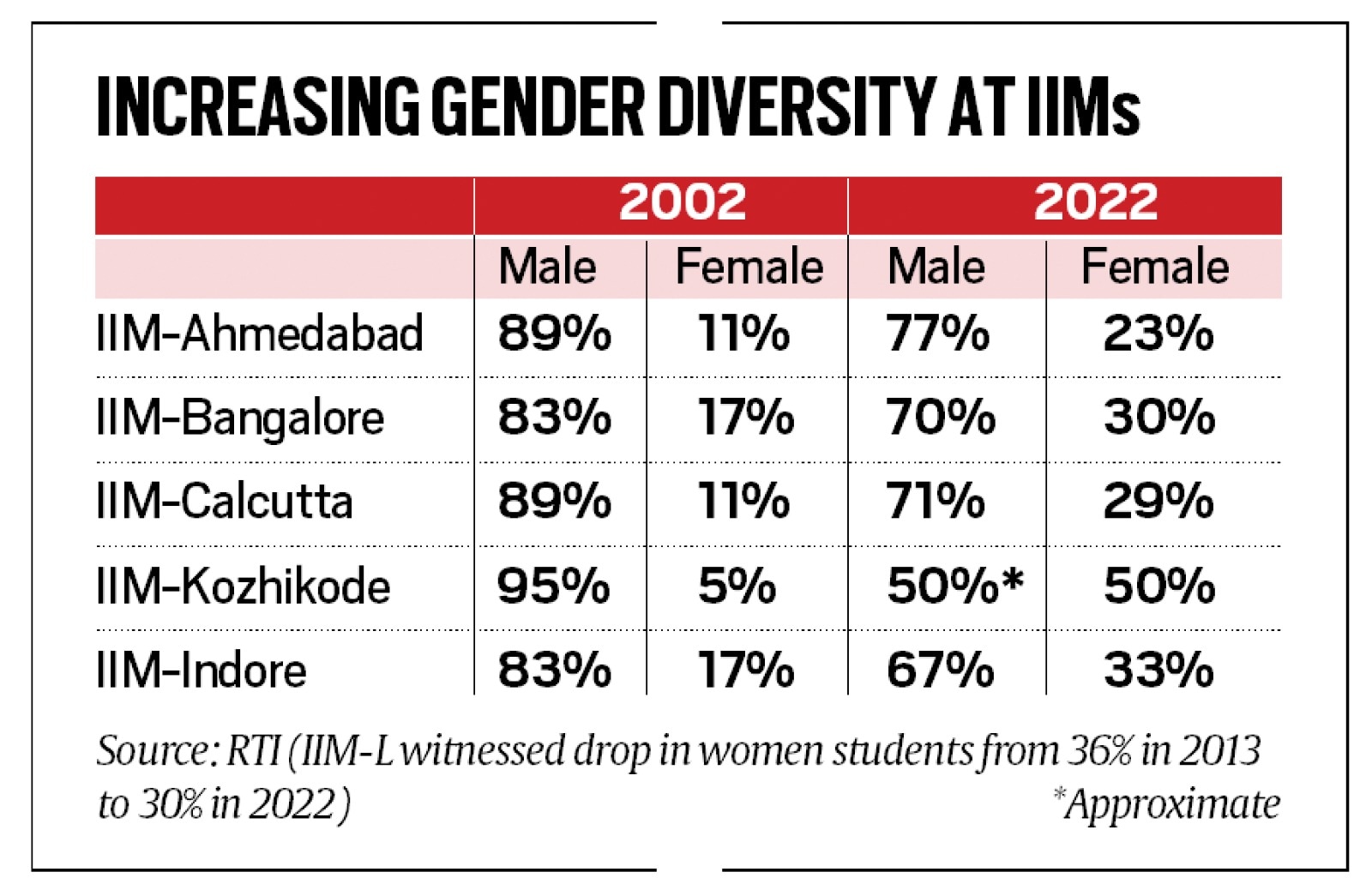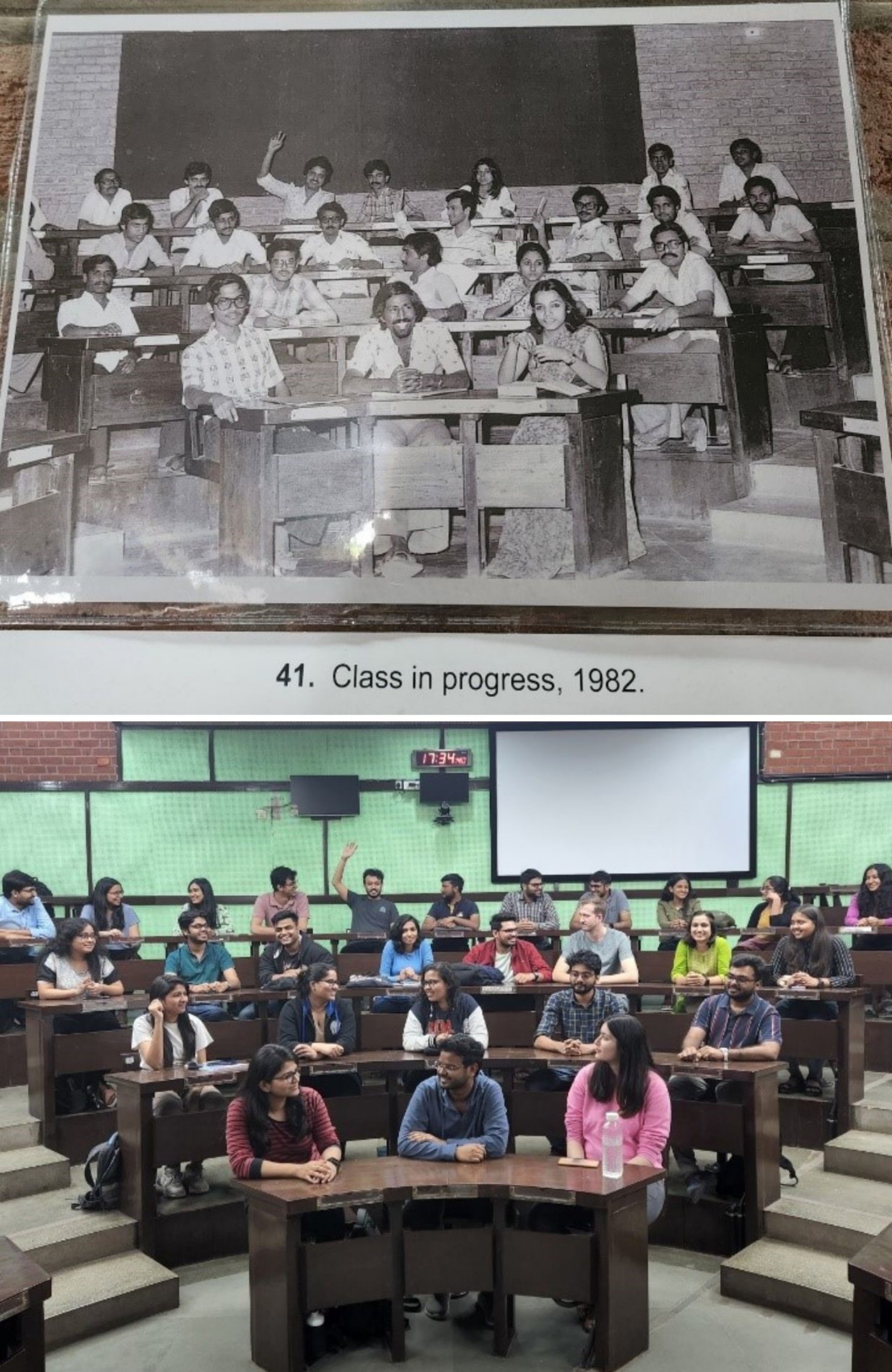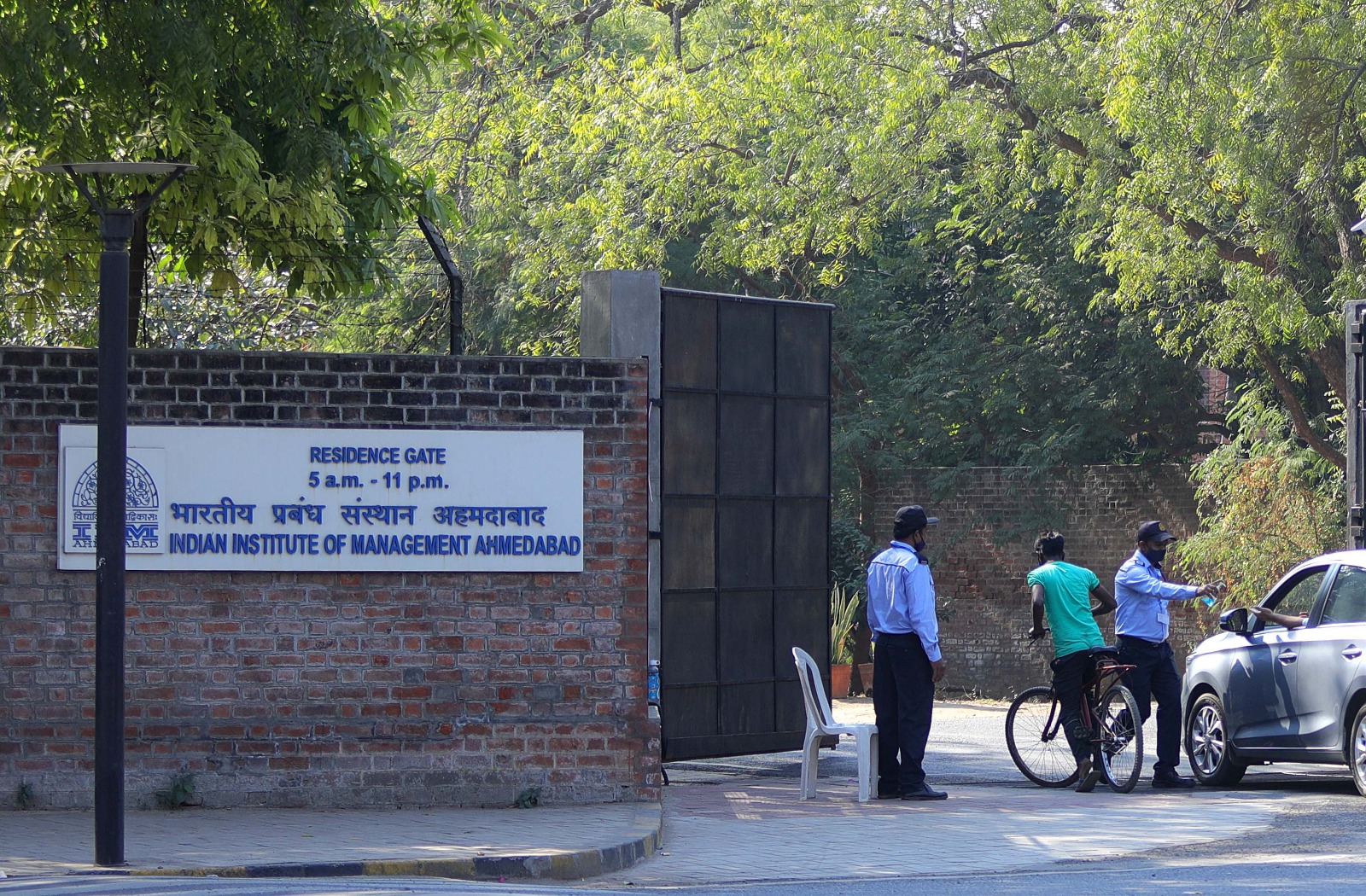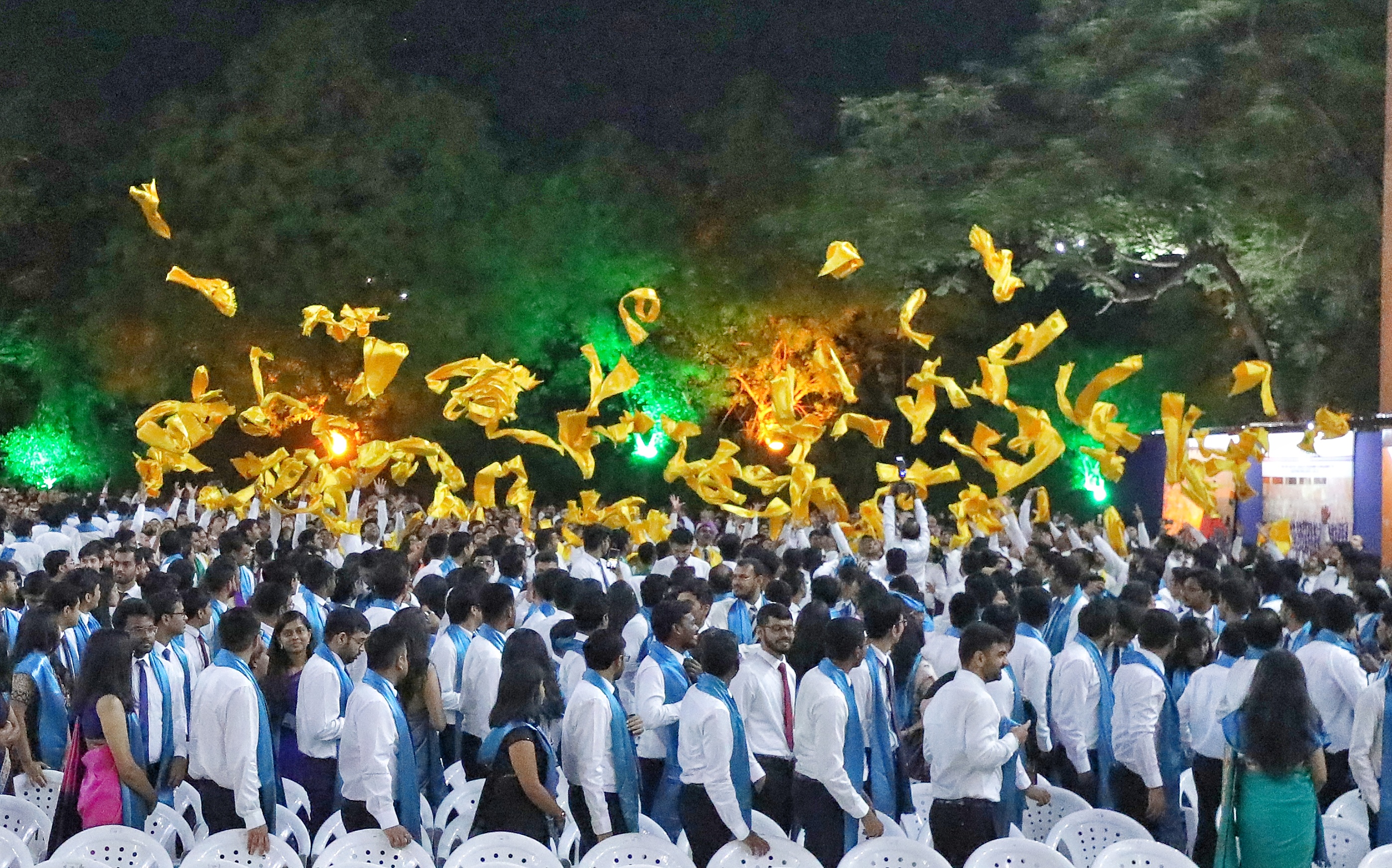The changing IIM: Over two decades, more and more women; engineers still dominate but their share dips
Share of women doubles in five of the old IIMs; at IIM Ahmedabad, a third of the 2022-24 batch comprises non-engineers, up from just 5% a decade ago
 Class in progress, 1982 at Indian Institute of Management Ahmedabad. (IIMA Archives)
Class in progress, 1982 at Indian Institute of Management Ahmedabad. (IIMA Archives)Traditionally dominated by men and engineering graduates, classrooms of the country’s premier business schools, the Indian Institutes of Management (IIMs), are changing with a sharp increase in women’s enrollment and a steady decline in the share of engineers over the last two decades.
From 13% of the intake 20 years ago, women students now make up almost a third (31%) of the students at the first-generation IIMs. Also, while students from engineering backgrounds still dominate these schools, they are down from 90% a decade ago to 66% now.
The Indian Express analysed admission data, obtained under the Right to Information Act, of the flagship two-year postgraduate programme (PGP) at the six IIMs — Ahmedabad, Bangalore, Calcutta, Kozhikode, Lucknow and Indore — to find that in the last 20 years, the proportion of women in the classroom has at least doubled in five of them.
Efforts by IIMs to enhance academic diversity have seen pronounced gains, with the proportion of students from non-engineering backgrounds at least doubling, if not more, at each of the six first-generation IIMs over the last decade.
Gender diversity
While the number of seats across the five older IIMs have more than tripled — from 718 to 2,366 — the number of women across these institutes has surged, almost seven-fold, from 90 to 733. The most significant increase has been at IIM Kozhikode, where the representation of women increased from 5% in 2002, with only three women in a batch of 60 students, to nearly half of the roughly 600 new inductees in the 2022-24 batch.
Similarly, at the top three institutes — IIM Ahmedabad, IIM Bangalore and IIM Calcutta — women representation in the classroom increased from 11% to 23%, from 17% to 30% and from 11% to 29% respectively.
 Increasing gender diversity at IIMs
Increasing gender diversity at IIMs
At IIM Indore, there was a dramatic shift in the percentage of women students, with their numbers rising from 17% in 2002 to 33% in 2022.
As of 2022, IIM Ahmedabad has the lowest proportion of women in the classroom at 23%, while IIM Kozhikode had the highest, at almost 50%.
IIM Lucknow — the only institute to provide data for the last decade and not for 20 years — saw a slight decline in the proportion of women, from 36% in the 2013-15 batch to 30% in the 2022-24 batch.
IIM Kozhikode director Debashis Chatterjee attributed this to a concerted effort by the institute. “We actively began working to increase diversity in our MBA programmes in 2012 due to the low number of women applicants and admissions. Initially, we considered Class 10 and 12 marks (as part of our admission criteria), which helped improve gender diversity. As a result, gender diversity at IIM Kozhikode has consistently been higher than the national average of IIMs,” he said.
 More non-engineers in IIM classroom in 10 years
More non-engineers in IIM classroom in 10 years
At IIM Bangalore, director RT Krishnan told The Indian Express that women candidates have an edge since the institute introduced diversity points in 2015-16. However, he added, this advantage is only given at the initial stage. “During shortlisting of candidates for interviews, additional points are given to women candidates so there can be a good representation of women in interviews. No advantage is given while making offers for final selection,” he said.
IIM Indore, according to its director Himanshu Rai, has implemented measures beyond incentives in the admission process. “We prioritise campus safety and have introduced pre-joining tutorials for relatively tougher subjects, such as accounting and quantitative aptitude,” he said.
“This helps improve our pool of women candidates, since we have noticed that historically, fewer women take CAT (Common Admission Test) and this could be because of parental pressure or bias for relatively ‘softer subjects’,” he added.
 Job inexperience in the classroom
Job inexperience in the classroom
Although the proportion of women has increased significantly compared to 20 years ago, there are ups and downs, too.
For instance, at IIM Ahmedabad, women’s representation reached a peak of 29% (in a batch of 394 students) in 2014 but eventually dipped to 22% in 2022. At IIM Indore, the percentage of women was the highest in 2019 at 42% which dipped to 32% in 2022.
 Recreation of 1982’s classroom in 2022 by Prof. Chinmay Tumbe. (Source: IIMA Archives )
Recreation of 1982’s classroom in 2022 by Prof. Chinmay Tumbe. (Source: IIMA Archives )
“There is no single-time drop in gender diversity,” said IIM Indore’s Rai. “In the academic year 2023, a new phenomenon was witnessed: In the PGP-HRM (Human Resource Management) programme, 38 of the 39 candidates were women. This is the highest female representation in this programme. One reason is that women candidates may prefer the HR programme over the flagship (PGP) programme.”
The PGP-HRM programme at IIM Indore was started in 2018.
Engineers vs non-engineers
Over the last decade, the proportion of students from non-engineering backgrounds has at least doubled at each of the six first-generation IIMs. As of 2022, Lucknow had the highest non-engineers in the classroom and IIM Bangalore the lowest.
IIM Lucknow’s class profile exhibits the most significant shift — the percentage of non-engineers increased from 15% (of 414 students) in 2013 to 55% (of 513 students) in 2022. It was followed by IIM Kozhikode, where students with undergraduate degrees other than B.Tech increased from 15% in 2013 to 41% in 2021 (IIM Kozhikode did not provide data for 2022).
 At IIM Ahmedabad, a third of the 2022-24 batch comprises non-engineers, up from just 5% a decade ago. (File Photo)
At IIM Ahmedabad, a third of the 2022-24 batch comprises non-engineers, up from just 5% a decade ago. (File Photo)
At IIM Ahmedabad, a third of the 2022-24 batch comprises non-engineers, marking a significant increase from just 5% a decade ago. Similarly, at IIM Calcutta and IIM Indore, this category has risen from 9% to 23% and from 11% to 33% between 2013 and 2022 respectively.
Among the six old institutes, IIM Bangalore has seen the slowest growth in this student group, with the percentage of non-engineers increasing from 9% (37 students in a class of 403) in 2013 to 18% (88 students in a class of 480) in 2022.
This rise, said Madhur Singhal, managing partner and CEO of Praxis Global, a consulting and knowledge services firm, may be a result of the diversification of academic choices. “Talent is now more uniformly distributed across professions compared to 10 years ago, when engineering was the undergraduate degree of choice. Today, more students are selecting their undergraduate courses based on their interests and capabilities,” Singhal said.
Work experience
When it comes to prior professional experience of students in the classroom, it’s a mixed bag. Among the five older IIMs (Ahmedabad, Calcutta, Kozhikode, Lucknow and Indore) that shared data on work experience of candidates admitted to PGP programmes from 2013 to 2022, IIM Calcutta and IIM Indore have shown a steady increase in the number of candidates with no prior employment.
 IIM Ahmedabad graduates during their annual convocation ceremony. (Express Photo by Nirmal Harindran)
IIM Ahmedabad graduates during their annual convocation ceremony. (Express Photo by Nirmal Harindran)
At IIM Calcutta, the percentage of candidates with job experience declined from 325 (71%) in a batch of 458 students in 2013 to 288 (60%) out of 480 students in 2022. At IIM Indore, those who had jobs before studying business administration made up 60% of the 454-student batch in 2013, dropping to 44% 10 years later.
IIM Ahmedabad and IIM Kozhikode witnessed the opposite. While the former saw the proportion of students with no professional experience fall from 29% to 20% over 10 years, the latter witnessed a decrease from 41% to 28% from 2013 to 2021 (IIM Kozhikode did not provide data for 2022).
Manish Sabharwal, vice-chairman of Team Lease Services, termed the rise of students with lesser work-experience “a bug more than a feature”. He said, “I think the cutting off of government resources is forcing IIMs to focus on revenues and expand seats very fast. With an entry gate that focussed purely on a test, younger candidates will always have an unfair advantage over older candidates with work experience at taking tests.”
(With inputs from Raunaq Saraswat in New Delhi)


- 01
- 02
- 03
- 04
- 05





























